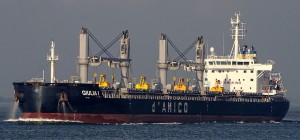
One mariner died and four others were injured when a massive wave struck an Africa-bound bulk carrier sailing in the North Atlantic during a severe storm.
The 580-foot Giulia I was roughly 370 miles southeast of Halifax, Nova Scotia, when the wave hit the ship at about 1400 on Jan. 30. The deceased mariner, a 30-year-old AB from the Philippines, was among a handful of crew working on the ship’s forecastle trying to stop flooding into the bow.
Karl Risser, a Canada-based inspector with the International Transport Workers’ Federation (ITF), said the victim suffered severe head trauma and died aboard the ship. Another AB, an ordinary seaman, the bosun and a maritime cadet suffered non-life-threatening injuries.
“They were on the (forecastle) deck working around the hawsepipes where the chain locker is,” Risser said. “Water was going down into the chain locker, and they were trying to plug it up with cement.”
Giulia I is registered in Malta and most of the crewmembers on the voyage were from the Philippines. Details about the incident, including where the wave hit the ship and how it injured the crew, are subject to an investigation being carried out by Maltese authorities, Risser said.
The ship departed the Port of Virginia on Jan. 26 with a cargo of soybeans. The captain diverted to Halifax after the incident on deck, and the bulker arrived early on Feb. 1.
Transport Canada conducted an investigation through port state control when the ship arrived in Halifax. The inquiry uncovered a series of deficiencies based on the Maritime Labour Convention and International Safety Management Code, the agency said in a prepared statement.
It’s not clear specifically what Canadian inspectors found. Transport Canada said privacy rules precluded it from disclosing those details.
“The vessel will remain alongside at the Port of Halifax pending rectification of all items to the satisfaction of port state control,” the statement said.
The ITF raised numerous questions about the incident, including the decision to sail into an area where forecasters had predicted severe weather. Risser also called it “questionable” to send the crew onto the deck during the rough sea conditions the ship was encountering.
The National Oceanic and Atmospheric Administration (NOAA) Ocean Prediction Center warned of a storm off the northeastern United States with waves up to 52 feet, the ITF said. It’s not clear what conditions the ship encountered or if the captain received updated weather forecasts like those issued by NOAA.
The ITF, an international federation of labor organizations, has maritime inspectors working in 57 countries around the world. Looking out for seafarers, many from countries with lower labor standards than those in the U.S., is a primary objective, Risser said.
The ITF worked with the Philippine consulate in Nova Scotia to support the surviving crew aboard Giulia I, many of whom suffered from anxiety and other distress related to the crewmember’s death. The ITF and Philippine officials arranged for limited shore leave and helped coordinate notification of the dead mariner’s next of kin, Risser said.
Maltese authorities began their investigation soon after the ship arrived in Halifax. The country’s maritime investigations are carried out by Transport Malta, which interviewed crewmembers remotely due to challenges posed by the COVID-19 pandemic.
Giulia I was built in 2014. It is owned by Venice Shipping and Logistics and managed by another Italian firm, Ships Surveys and Service. Danish shipper Falcon Maritime A/S chartered the bulk carrier. Attempts to reach these companies for comment about the incident were not successful.
Casey Conley
